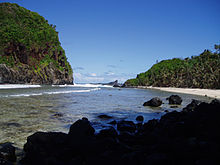ʻAmanave, American Samoa
After the tsunami, some residents followed the advice of the Federal Emergency Management Agency (FEMA) and moved into houses on a higher elevation.
[1] Its mayor Aveao Faausu Fonoti received the Community Resiliency Leadership Award at the National Disaster Preparedness Training Center in 2010, due to his handling of the 2009 tsunami.
The executive director of the center told reporters: "In spite of the fact that something like eighty percent of his village was destroyed, there were no casualties.
During World War II, the single-lane roads which for long had been connecting Alofau in the east to ʻAmanave in the west proved inadequate for military requirements.
The islet is home to various species of shrubs and trees, including Desmodium umbellatum, Morinda citrifolia, Premna obtusifolia, Ficus scabra, Gardenia taitensis, and Barringtonia asiatica.
Additionally, tree species such as Cocos nucifera (coconut palm), Thespesia populnea, Pisonia grandis, Grewia crenata, Diospyros elliptica, and Ficus tinctoria are found on the island.

